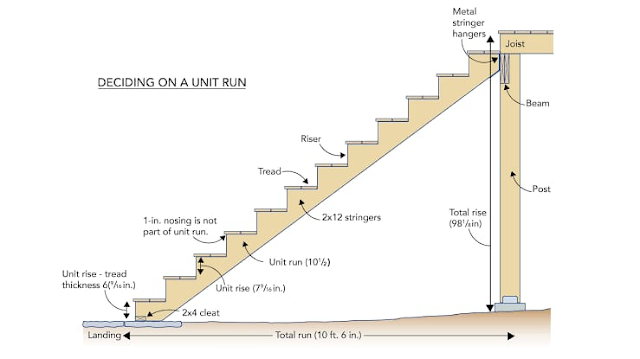How To Make Stair Stringers
How To Make Stair Stringers. Stair stringers are the structural supports that are used to hold the treads (horizontal steps) and risers (vertical parts) of a staircase. They are typically made of wood or metal and are designed to provide stability and support for the stairs.
Stair stringers are usually installed on either side of the staircase and are responsible for bearing the weight of the treads and risers. The treads and risers are then attached to the stringers to create a functional and safe staircase.
There are different types of stair stringers, including closed stringers, which have a solid, closed design, and open stringers, which have a more visually open appearance with cutouts or notches for the treads and risers. The choice of stringer type depends on the design and aesthetic preferences of the staircase.
When constructing or installing staircases, it's important to ensure that the stringers are properly sized, positioned, and secured to provide a sturdy and safe staircase.
Making stair stringers involves a few key steps to ensure proper construction and stability. Here's a general guide to making stair stringers:
- Gather measurements: Measure the total rise (vertical height) and total run (horizontal distance) of the staircase. Determine the desired tread depth and riser height for each step. It's important to consult local building codes to ensure compliance with safety regulations.
- Calculate the number of steps: Divide the total rise by the desired riser height to determine the number of steps needed. Round the result to the nearest whole number. Adjust the riser height if necessary to ensure even steps.
- Determine the tread depth: Divide the total run by the number of steps to calculate the tread depth for each step. Ensure the tread depth is consistent and comfortable to walk on.
- Establish the stringer dimensions: Decide on the width and thickness of your stringers based on the load requirements and material availability. Typically, 2x12-inch lumber is used for wooden stringers, but you can adjust the dimensions as needed.
- Lay out the stringer: Mark the bottom and top of the stringer on a piece of lumber. Use a framing square to create the pattern of each step on the stringer. Mark the rise and run for each step, ensuring the dimensions match your calculations.
- Cut the stringer: Carefully cut along the layout lines using a circular saw or a handsaw. Start with the riser cuts, and then make the tread cuts. Repeat the process for multiple stringers if required.
- Test fit and adjust: Place the stringers in position to ensure they fit properly against the deck or landing. Make any necessary adjustments to ensure a secure fit and level installation.
- Install the stringers: Attach the stringers to the deck or landing using appropriate fasteners, such as brackets or hangers. Ensure they are securely anchored and level. Add additional support if needed.
- Install treads and risers: Attach the treads and risers to the stringers, starting from the bottom and working your way up. Secure them using screws or nails, ensuring they are properly aligned and provide a stable walking surface.
- Finish the staircase: Apply any desired finishing touches, such as sanding, painting, or staining, to enhance the appearance and durability of the stairs.
Remember, this is a general guide, and specific construction techniques may vary depending on the design, materials used, and local building codes. It's always recommended to consult with a professional or reference detailed construction guides for precise instructions tailored to your specific project.
Tag :
What is the formula for stair stringers?, How do you make simple stair stringers?, Do you need 2 or 3 stringers for stairs?, What is the best size for stair stringers?, how to make stairs.







